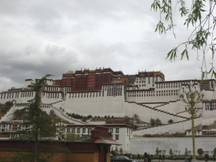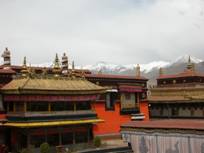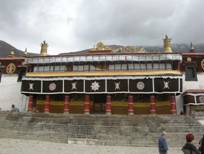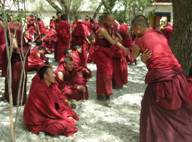Attractions in Lhasa
Potala Palace

Built for several purposes, the Potala served as administrative center, seat of government, monastery, fortress and the home of all the Dalai Lamas from the Fifth to the Fourteenth, although from the end of the eighteenth century, when the Norbulingka was built as the summer palace, they stayed here only in winter.
The general layout of the Potala includes the White Palace for the living quarters of the Dalai Lama and the Red Palace for religious functions. The Red Palace contains many halls and chapels- the most stunning chapels house the jewel-bedecked tombs of 5th to 13th Dalai Lamas. The apartments of the 13th and 14th Dalai Lamas in the White Palace offer an insight into the high life.
The Potala is a treasure and a treasure house, that it contains the golden handwritten Buddhist scriptures, valuable gifts from Chinese emperors, and a lot of priceless antiques. There are many colorful sculptures and paintings chronicling Buddhist folklore and ancient Tibetan life. The Potala Palace deserves the title of art gallery and museum; it is also a symbol of the wisdom and power of the Tibetan people. In 1994 it was listed as an UNESCO world cultural heritage site.
Jokhang Temple

The golden-roofed Jokhang is 1300 years old and one of Tibet's holiest shrines. It was built to commemorate the marriage of the Tang princess Wen Cheng to King Songtsen Gampo, and house a pure gold statue of the Buddha Skyamuni brought to Tibet by the princess in the year of 700 A.D.
Located in the center of old Lhasa, the temple was built by craftsmen from Tibet, inland China, and Nepal and thus features different architectural styles. The temple is also the spiritual center of Tibet and the holiest destination for all Tibetan Buddhist pilgrims.
Barkhor Street
The Barkhor is essentially a pilgrim circuit which is followed clockwise round the periphery of the Jokhang. Shaped roughly like an octagon, it is also a hive of market activity.
Lined with the shop stalls and teahouses, the outdoor market sells all manner of goods including saddles and stirrups, Chinese army gear, thangkas, jewelry, blankets, carpets, etc. The whole Bakhor area is worth exploring with huge wooden doors set in long white walls leading into hidden courtyards surrounded by traditional stone houses.
Norbuligka
Situated about 3 km in the west of the town, the Norbulingka used to be the Summer Palace of the Dalai Lama. The pleasant park consists of small palaces, chapels and a zoo.
In the past, each spring a grand procession of lamas would follow the Dalai Lama to move into the park. Before 1959, common people had no access to the palace.
Drepung Monastery

Drepung, which means rice heap in Tibetan language, lies 8 kilometers west of Mt. Gambo Utse. The monastery covers more than 200 thousand square meters. Once the largest monastery in the world, it was founded in 1416 by Jamyang Chojey, a leading disciple of Tsongkhapa. It was an immediate success and a year after opening there were already two thousand monks in residence and ten thousand by the time of the Fifth Dalai Lama (1617-82). The main structures of the monastery include the Main Assembly Hall (known as Tshomchen), four Tantric colleges and Ganden Palace (Ganden Potrang).
Sera Monastery
About 4 km north of Lhasa, the monastery was built in 1419 by Sakya Yeshe, a disciple of Tsongkhapa. It is named after the wild rose flowers grown on the slope of mountains nearby.

About 600 monks are now in residence, well down from an original population of 5000. Debating takes place from 3 pm in a garden next to the central assembly hall (jepa Duchen) in the center of the monastery. All pilgrims proceed on a clockwise circuit visiting the three main colleges: Sera Me, Sera Ngag-pa and Sera Je. Sera's collection of murals is maintained in perfect, original condition. Its statues of Maitreya, Bodhisattvas, and Arhats are very noteworthy. Scriptures written in gold powder, scroll paintings, a tapestry portrait of Jamchen Chojey, and thangkas can be seen throughout Sera.
Ganden Monastery
Notably situated high up on the Gokpori Ridge about 45km east of Lhasa, the monastery was finished on 1410 by Tsongkhapa himself. But the main hall was not completed until 1417, two years before his death.
Ganden monastery is the first Gelugpa monastery in Tibet. Its tripa, abbot of the monastery, is actually the Throne Holder of Gelugpa, which is Panchen Lama and Dalai Lama's order.
The monastery has extremely delicate and fine murals and sculptures. It also keeps an armor decorated with gems, which was worn by Emperor Qianlong and was bestowed to the monastery as an offering to Tsongkhapa. Its thangkas are special and similar with embroideries originating in south China. The most important and valuable arts left are the paintings of Buddha and Jataka stories drawn by the First Panchen Lama.

